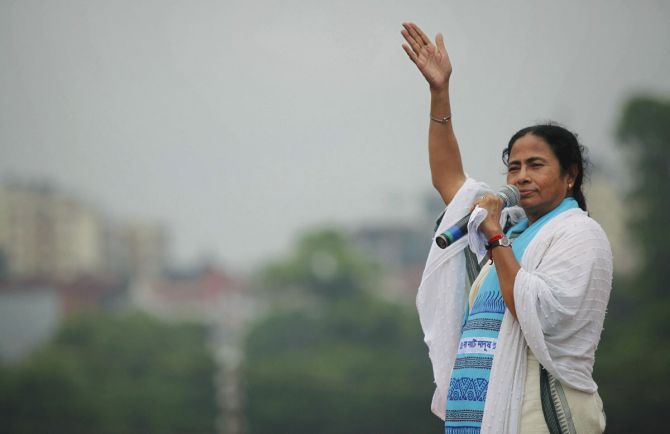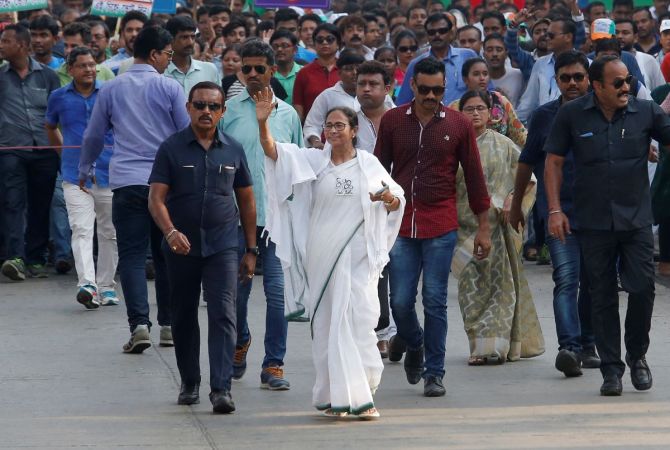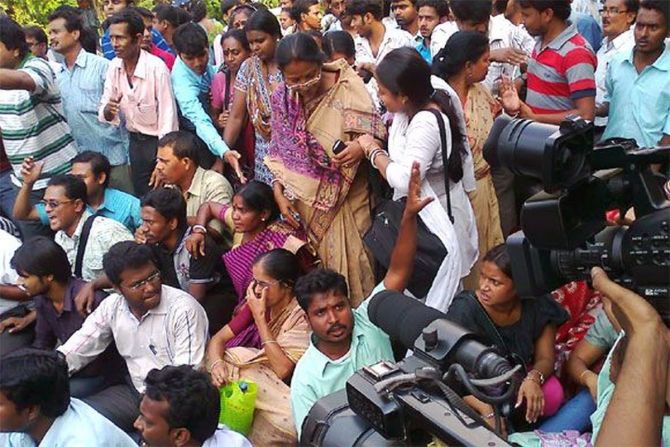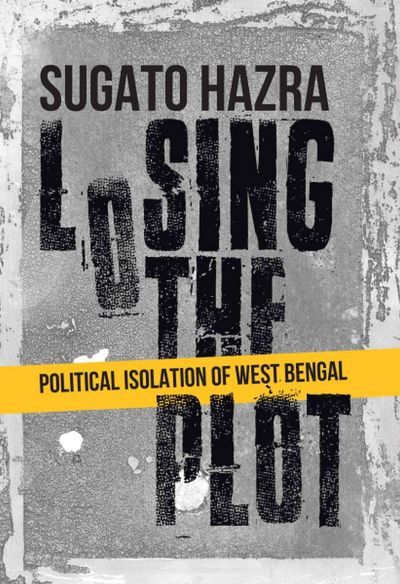Hasty, ill-conceived steps show how isolated Mamata Banerjee had been from the national political trend.
A fascinating excerpt from Sugato Hazra's Losing The Plot: Political Isolation Of West Bengal.

Mamata Banerjee espouses the worst aspects of the politics of plebianisation.
She won the election in 2011 on the back of the support from the lumpen proletariat, the landless and marginal farmers who lost out or were stuck at the lowest strata under the Left's rural economic policy and rule of panchayat.
She also received support from the so-called 'Sushil Samaj', the intellectuals who were perturbed over the changed policies of the Left Front government.
She had the backing of the Maoists too who were engaged in a bloody battle with the Left administration.
The support of the Sushil Samaj, the well-meaning intellectuals, helped her immensely in her image makeover -- Mamata was transformed as a potential leader capable of addressing the faults of the Left Front rule, a different image from the volatile street activist.
This Sushil Samaj formed the face of civil society and were out on the streets, pointing to the Left Front's deficits.
The image makeover process involved sidelining the lumpen-based party organisation of the Trinamool Congress, which had not been accepted earlier by the people, and bringing the elite to the forefront of the election campaign.
So there was a silent alliance of the anti-Left, particularly anti-Communist, elite and the party faithful. Both sections calculated on overthrowing the other after victory and Banerjee did nothing to dissuade them.
In addition, this being the age of neo-liberal policies, Banerjee had the support of domestic capitalists, who, encouraged by the much-discussed potential of 'Look East' policies, were interested in investing in the state.'

Dipankar Sinha, a professor of political science in Calcutta University, called the politics of West Bengal as 'same side goal politics'.
Enumerating further he said: 'In it, the concerned actors in politics would act in such a manner that they themselves would put their own party in a disadvantageous position, rather than letting or waiting for their competitors to do so.'
Sinha cited two examples of scoring self-goals by the ruling TMC.
One was the death of a student activist of the CPI-M student wing in police custody, and the other was the handling of the Kamduni rape and murder case.
The unfortunate death of the student was called a 'small affair', and the young women who protested the Kamduni crime were denigrated.
Evidently, the TMC had no use of the Sushil Samaj any more.
It also had no use of the Congress government at the Centre since by 2013 it was clear that in the 2014 election the party would find it difficult to retain its power.

With the emerging face of Narendra Modi as BJP's candidate for the top job Mamata Banerjee saw an opportunity to strengthen her hold in national politics.
She knew that if the TMC could bag a substantial number of seats from the state, in case of a hung Lok Sabha she would call the shots, like the CPI-M had done in the past.
She even sought support from Anna Hazare who was used by Arvind Kejriwal. Using Anna Hazare and his ability to fast, Kejriwal came out of nowhere and managed to become the chief minister of Delhi and was next testing the waters for a crack at the post of prime ministership in 2014.
He even took a dip in the Ganga, visited some temples and went on to contest against Narendra Modi.
Mamata planned for a rally in Delhi after obtaining endorsement of Anna Hazare, but Anna skipped the rally since there was hardly any crowd. He even backtracked on his endorsement of Mamata as a potential prime ministerial face.
Mamata's political naivety was seen earlier also when she landed in the national capital to canvass Dr A P J Kalam as the President for the second term. She claimed that Mulayam Singh Yadav would join her in endorsing Dr Kalam.
Mamata's personal dislike of Pranab Mukherjee who was then emerging as the frontrunner for the post led her to more theatrics.
After getting snubbed by the Congress, she wrote in a Facebook post, her maiden appearance on the medium, seeking support for Dr Kalam.
She even suggested the name of former West Bengal governor Gopalkrishna Gandhi as well as Meira Kumar -- anybody but Pranab seemed to be her politics.
Finally, she had to fall back on supporting Pranab Mukherjee realising that the people in West Bengal would like to see Pranab babu as the nation's President.
Impetuousness had been the hallmark of Mamata's politics.
These hasty, ill-conceived steps also show how isolated Mamata Banerjee had been from the national political trend.

Power was a new experience for Mamata Banerjee.
The international exposure she received for defeating the Left Front made her dizzy with success.
Perhaps to maintain the tempo, Banerjee kept on resorting to theatrical moves, one after another.
Such moves, perhaps, she felt would make people hold her in awe and deprive the media the power of argument.
Opinion leaders of West Bengal could not have questioned Mamata's prime ministerial ambition.
The sub-national spirit, always present in suitable doses in the state, could not be insulted.
In suggesting Dr Kalam or Gopalkrishna Gandhi, Mamata tried to present a picture of a national politician who was not parochial to a potential Bengali candidate.
The TMC faced a major crisis when Sudipto Sen, the chairman of the Saradha Group of companies, was arrested in Kashmir on 23 April 2013, for allegedly defrauding lakhs of depositors who had invested in various schemes floated by his companies.
The still unsolved chit fund scam in West Bengal resulted in loss of crores of hard-earned savings of the middle and lower middle-class people of the state.

After the Saradha Group went bust, Mamata Banerjee told the duped investors, 'Let go whatever has gone'.
Realising her mistake within two days, she announced Rs 500 crore relief package for the hapless investors.
While Saradha started its operation in 2006 when the Left Front was in power, it expanded its presence manifold with the change of government.
Sudipto Sen started shifting his loyalty to the Trinamool Congress when the 'winds of change started blowing across Bengal after the 2008 panchayat elections'.
The political link got strengthened in the next few years as the media business launched by the group tried its best to give legitimacy to the new regime.
The Saradha case bears testimony to close ties between the media, politics and chit funds.
The group promoter Sen had supported the 2011 campaign of the TMC.
In 2011 Mamata Banerjee distributed ambulances, motorcycles and bicycles donated by the Saradha Group in Jangalmahal.
It is also reported that Sudipto Sen bought a painting of Banerjee for Rs 1.86 crore.

The TMC transport minister, Mr Madan Mitra, was appointed the president of the employees' union of the group.
Its MP Kunal Ghosh was the group's media head.
In 2010 the Left Front government had asked SEBI to investigate the group.
While the Left Front government too did not take enough steps to stop the company or alert the depositors of the trap they were walking into, the Mamata government emerged as a big support for the group.
The growing proximity between the ruling party and the Saradha group on the other hand helped in increasing the latter's credibility.
West Bengal had been a breeding ground for chit funds running Ponzi schemes.
The central government in reply to a question in the Lok Sabha had given a list of 73 companies from West Bengal which were running Ponzi schemes.
Excerpted from Losing The Plot: Political Isolation Of West Bengal by Sugato Hazra, with the kind permission of the publishers, Niyogi Books Pvt Ltd.
Feature Presentation: Aslam Hunani/Rediff.com










